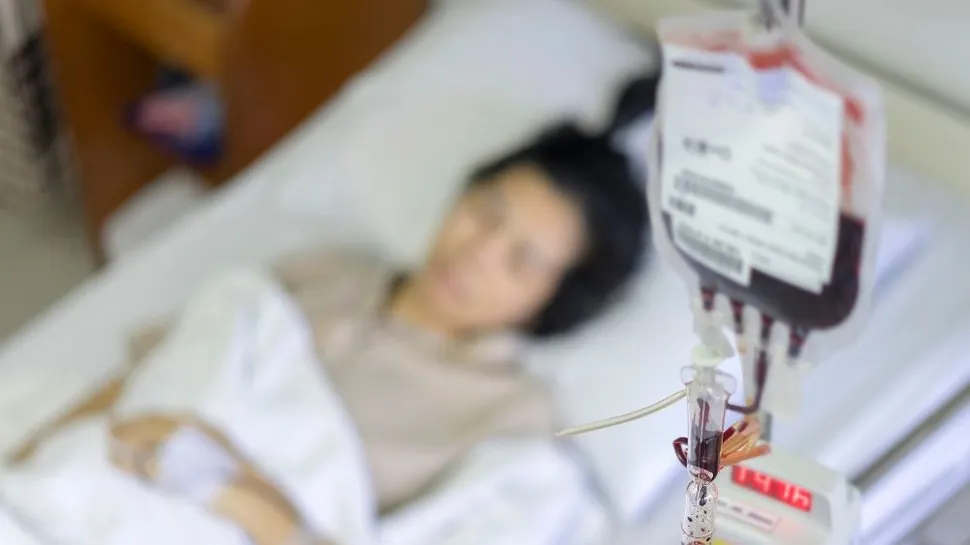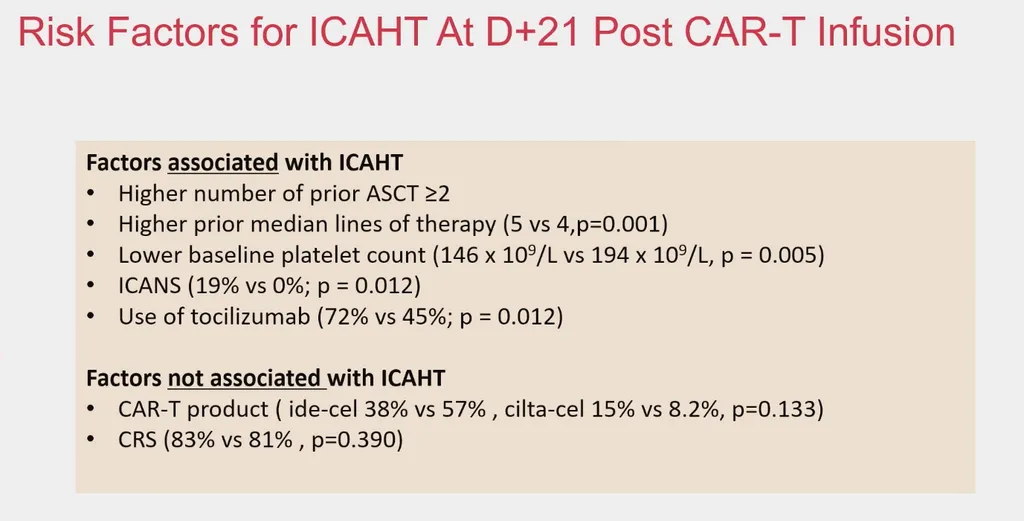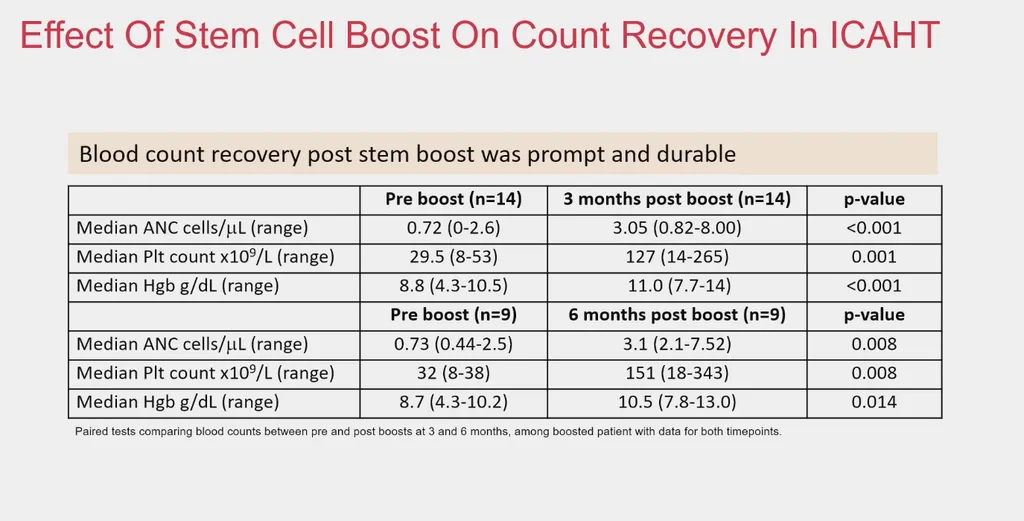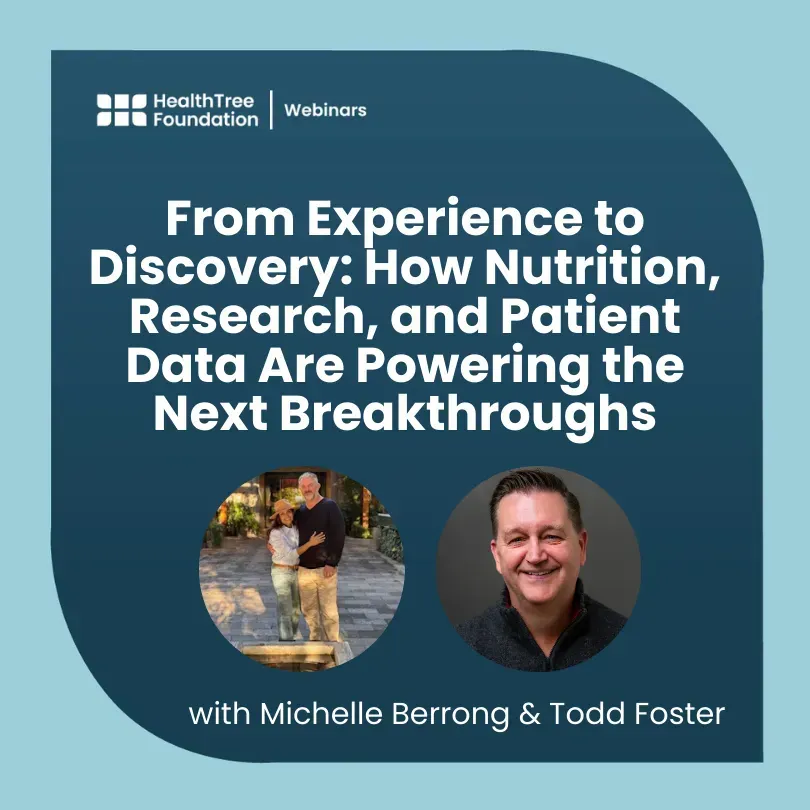ASH 2023: The Effect of Stem Cell Infusion on ICAHT after CAR-T Cell Therapy

Do you get sick often after receiving CAR T-cell therapy? This study from ASH 2023 is for you.
What I am discussing today is important because it attends to the significant number of patients who exhibited persistent Immune Effector Cell Associated Hematotoxicity (ICAHT) after a B Cell maturation antigen (BCMA) Car T with cilta-cel or ide-cel.
This can result in high rates of infection and or bleeding with increased mortality and inferior outcomes.
Understanding Low Blood Cell Counts
This discussion includes cytopenia which means low levels of platelets, red and or white blood cells. Platelets help stop bleeding, so when they are low you can experience excessive bleeding or bruising. Red blood cells contain hemoglobin that helps them carry oxygen to the tissues in the body. If there are low red blood cells, you can develop anemia.
White blood cells defend us against infection and injury. The neutrophil is the most common white blood cell. They are the cells that signal the immune system to get to work after an injury or infection.
If these cells get too low, the current treatment is a growth factor known as Granulocyte-colony stimulating factor (G-CSF). Unfortunately, it does not have lasting effects. All this is discussed in detail at this Healthtree article link: Neutrophils and Multiple Myeloma.
Study Details
This particular ASH study examines a different approach to treating low blood cell counts, the use of your own stored stem cells as the boost to your immune system that you may need after CAR T-Cell Therapy treatment.
Patients may discuss this option with their myeloma specialist before the CAR-T infusion. Most patients have stored stem cells that were gathered for a possible stem cell transplant earlier in the course of treatment.
Here is a look at what patients participated in this study.

For this ICAHT study, 108 patients receiving CAR-T in a clinical trial or commercially were selected between 2020 and 2023.
The patient's median age was 68 with 60% men and 40% female. 11% were black. 90% of the patients had undergone a stem cell transplant in the past and had a median of 5 prior lines of therapy.

The investigators were able to identify risk factors of ICAHT such as several prior lines of therapy previous to the CAR-T, prior autologous stem cell transplant (ASCT), decreased platelet count before the Car-T, or history of immune effector cell–associated neurotoxicity syndrome (ICANs) in previous myeloma therapies.
Factors that did not affect ICAHT were the type of CAR-T cell product or cytokine release syndrome.
They looked at three specific components to identify ICAHT for this study:
- Neutropenia was defined as an absolute neutrophil count (ANC) of ≤ 1000,
- Thrombocytopenia as platelet counts ≤ 70,000
- Anemia as hemoglobin ≤9 g/dL
Administering the Stem Cell Boost
Many of the patients showed ICAHT symptoms for the first 3 weeks, but it lessened overtime at their three and six-month checkups. Many of the patients in the study (97%) had stem cells in storage, thus reducing the need for apheresis (stem cell collection).
Out of the 108 patients, 28% received a stem cell boost. These are the cells that were in storage gathered before stem cell transplant. The time to this boost was a median of 116 days. The researchers used a median of 3.91x106 CD34/kg cells.
The researchers found significant improvements in three to six months in anemia and thrombocytopenia shown in measurements of platelets and hemoglobin.
The low white blood cell count or neutropenia via the lab test of absolute neutrophil count (ANC) levels showed a nonsignificant increase.
You can see the actual outcome data below. There was a significant increase in red blood cell hemoglobin and platelets, but not in the white blood cell counts.

The researchers attribute the lack of change in white blood cell count or absolute neutrophil count here to the higher use of granulocyte colony-stimulating factor (G-CFS) treatment which was discussed above in this article. This is often used to support in ICAHT patients who receive stem cell support.
- Hemoglobin levels increased to 10.6g/dL, p=0.002, and 10.5g/dl, p=0.02
- Mean platelet levels were 30x109/L vs 54x109/L, p=0.01
- ANC levels increased to 2.8/mL and 3.9/mL, and G-CSF support was discontinued
To learn more on this important topic, watch the video below.
Conclusions
In summary, this study proved that ICAHT is common after CAR T-cell Therapy. While 60% of patients experienced ICAHT after their CAR-T therapy, most of them recovered within 6 months.
The higher number of prior stem cell transplants and higher prior lines of therapy were indicators of getting ICAHT, as well as lower platelet counts, incidence of ICANS, and the use of tocilizumab.
Stem cell boosts were utilized in 28% of study participants with ICAHT, the median time to boost was 116 days, and the stem cell boost was safe and effective.
This is another easily available option for myeloma patients with stem cells in storage who might be recovering slowly from their CAR-T therapy treatment.
While we hope you won’t need it, the results are promising. It's comforting to have a backup plan with good data behind it. Please keep this in mind to discuss with your myeloma specialist.
ASH 2023 Resources
Would you like to watch ASH 2023 myeloma research interviews from the investigators themselves? Click "ASH 2023" here: HealthTree University Conference Coverage
To read other ASH 2023 articles, click here: HealthTree 2023 ASH Articles
Do you get sick often after receiving CAR T-cell therapy? This study from ASH 2023 is for you.
What I am discussing today is important because it attends to the significant number of patients who exhibited persistent Immune Effector Cell Associated Hematotoxicity (ICAHT) after a B Cell maturation antigen (BCMA) Car T with cilta-cel or ide-cel.
This can result in high rates of infection and or bleeding with increased mortality and inferior outcomes.
Understanding Low Blood Cell Counts
This discussion includes cytopenia which means low levels of platelets, red and or white blood cells. Platelets help stop bleeding, so when they are low you can experience excessive bleeding or bruising. Red blood cells contain hemoglobin that helps them carry oxygen to the tissues in the body. If there are low red blood cells, you can develop anemia.
White blood cells defend us against infection and injury. The neutrophil is the most common white blood cell. They are the cells that signal the immune system to get to work after an injury or infection.
If these cells get too low, the current treatment is a growth factor known as Granulocyte-colony stimulating factor (G-CSF). Unfortunately, it does not have lasting effects. All this is discussed in detail at this Healthtree article link: Neutrophils and Multiple Myeloma.
Study Details
This particular ASH study examines a different approach to treating low blood cell counts, the use of your own stored stem cells as the boost to your immune system that you may need after CAR T-Cell Therapy treatment.
Patients may discuss this option with their myeloma specialist before the CAR-T infusion. Most patients have stored stem cells that were gathered for a possible stem cell transplant earlier in the course of treatment.
Here is a look at what patients participated in this study.

For this ICAHT study, 108 patients receiving CAR-T in a clinical trial or commercially were selected between 2020 and 2023.
The patient's median age was 68 with 60% men and 40% female. 11% were black. 90% of the patients had undergone a stem cell transplant in the past and had a median of 5 prior lines of therapy.

The investigators were able to identify risk factors of ICAHT such as several prior lines of therapy previous to the CAR-T, prior autologous stem cell transplant (ASCT), decreased platelet count before the Car-T, or history of immune effector cell–associated neurotoxicity syndrome (ICANs) in previous myeloma therapies.
Factors that did not affect ICAHT were the type of CAR-T cell product or cytokine release syndrome.
They looked at three specific components to identify ICAHT for this study:
- Neutropenia was defined as an absolute neutrophil count (ANC) of ≤ 1000,
- Thrombocytopenia as platelet counts ≤ 70,000
- Anemia as hemoglobin ≤9 g/dL
Administering the Stem Cell Boost
Many of the patients showed ICAHT symptoms for the first 3 weeks, but it lessened overtime at their three and six-month checkups. Many of the patients in the study (97%) had stem cells in storage, thus reducing the need for apheresis (stem cell collection).
Out of the 108 patients, 28% received a stem cell boost. These are the cells that were in storage gathered before stem cell transplant. The time to this boost was a median of 116 days. The researchers used a median of 3.91x106 CD34/kg cells.
The researchers found significant improvements in three to six months in anemia and thrombocytopenia shown in measurements of platelets and hemoglobin.
The low white blood cell count or neutropenia via the lab test of absolute neutrophil count (ANC) levels showed a nonsignificant increase.
You can see the actual outcome data below. There was a significant increase in red blood cell hemoglobin and platelets, but not in the white blood cell counts.

The researchers attribute the lack of change in white blood cell count or absolute neutrophil count here to the higher use of granulocyte colony-stimulating factor (G-CFS) treatment which was discussed above in this article. This is often used to support in ICAHT patients who receive stem cell support.
- Hemoglobin levels increased to 10.6g/dL, p=0.002, and 10.5g/dl, p=0.02
- Mean platelet levels were 30x109/L vs 54x109/L, p=0.01
- ANC levels increased to 2.8/mL and 3.9/mL, and G-CSF support was discontinued
To learn more on this important topic, watch the video below.
Conclusions
In summary, this study proved that ICAHT is common after CAR T-cell Therapy. While 60% of patients experienced ICAHT after their CAR-T therapy, most of them recovered within 6 months.
The higher number of prior stem cell transplants and higher prior lines of therapy were indicators of getting ICAHT, as well as lower platelet counts, incidence of ICANS, and the use of tocilizumab.
Stem cell boosts were utilized in 28% of study participants with ICAHT, the median time to boost was 116 days, and the stem cell boost was safe and effective.
This is another easily available option for myeloma patients with stem cells in storage who might be recovering slowly from their CAR-T therapy treatment.
While we hope you won’t need it, the results are promising. It's comforting to have a backup plan with good data behind it. Please keep this in mind to discuss with your myeloma specialist.
ASH 2023 Resources
Would you like to watch ASH 2023 myeloma research interviews from the investigators themselves? Click "ASH 2023" here: HealthTree University Conference Coverage
To read other ASH 2023 articles, click here: HealthTree 2023 ASH Articles

about the author
Beth Travis
Beth is a licensed Physical Therapist that truly believes in the benefits of exercise. Mother of two, a myeloma patient and advocate with a love of learning, healthy lifestyles and food adventures.
More on Conferences
Trending Articles
Upcoming Events




Get the Latest Multiple Myeloma Updates, Delivered to You.
By subscribing to the HealthTree newsletter, you'll receive the latest research, treatment updates, and expert insights to help you navigate your health.
Together we care.
Together we cure.
3x Faster.












